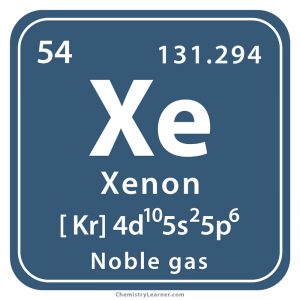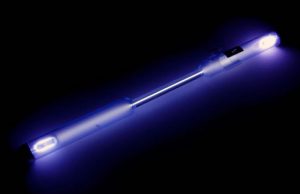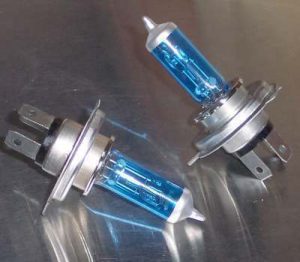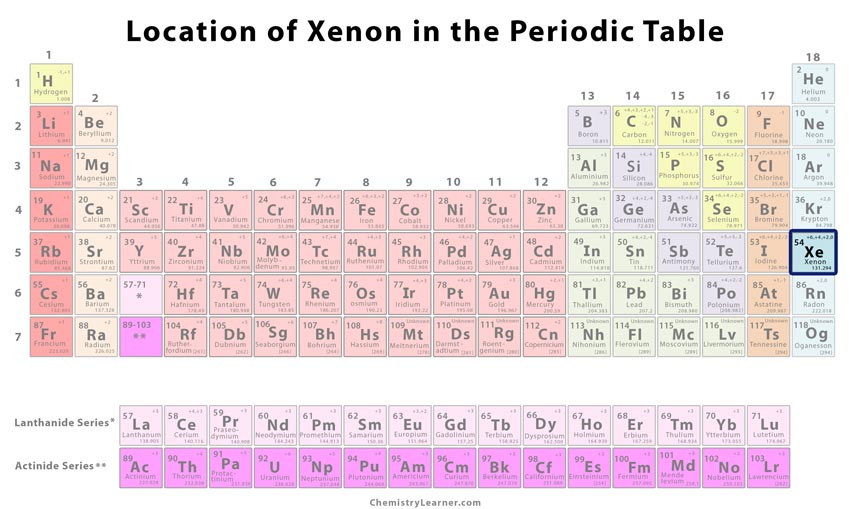Xenon
What is Xenon
Xenon (pronunciation: ZEE-non) is a colorless, odorless, highly unreactive element classified as a noble gas and represented by the chemical symbol Xe [1, 2]. It is denser and heavier than most of the other noble gases and can be synthesized into xenon hexafluoroplatinate, the first noble gas compound [3]. Despite being inert, it can be used to produce other compounds like xenon tetrafluoride (XeF4), xenon difluoride (XeF2), xenon hexafluoride (XeF6), xenon trioxide (XeO3), perxenate (H4XeO6), xenon dichloride (XeCl2), and xenon hydrate [4].
Isotopes of Xenon
Xenon is characterized by nine naturally occurring isotopes, out of which eight (124Xe, 126Xe, 128Xe, 129Xe, 130Xe, 131Xe, 132Xe, and 134Xe) are stable and 136Xe with a half-life period greater than 2.165 X 1021 years [5, 6]. In addition to the stable forms, more than 30 unstable isotopes have been studied [6].
Where is Xenon Found
It is found in the Earth’s atmosphere in trace amounts, at about 0.086 parts in one million by volume [1]. Down on the surface, it can be obtained from some mineral springs that emit gases [1, 4]. It can be commercially extracted from liquid air, which is ordinary air liquefied by compression when cooled to extremely low temperatures [1].
History
Origin of its Name: The element’s name is derived from ‘xenos’, the Greek word for stranger [1].
Who discovered it: The Scottish chemist, Sir William Ramsay, along with the English chemist, Morris William Travers discovered xenon [1].
When and How was it Discovered
In July 1898, Morris Travers and William Ramsay while working on liquid air at the University College London, discovered xenon [1]. Since they had already isolated other noble gases from the liquid air, they thought that it would contain other gases [1]. A wealthy entrepreneur gave Travers and Ramsay a liquid-air machine, which they used to extract more krypton [1]. By distilling it several times, they isolated a heavier inert gas that produced a blue glow after it was carefully analyzed in a vacuum tube [1]. They understood that it was a new member of the noble gases and named it xenon.
In 1962, Neil Bartlett used it to produce a fluorine derivative, indicating that xenon was not chemically unreactive [1]. Today, more than 100 compounds of xenon have been produced [1].
Xenon Identification |
|||
| Atomic number | 54 [1, 2] | ||
| CAS number | 7440-63-3 [1] | ||
| Position in the periodic table | Group | Period | Block |
| 18 [1] | 5 [1, 2] | p [1] | |
Properties and Characteristics of Xenon
General Properties |
||||||||||||||||
| Relative atomic mass | 131.293 [1] | |||||||||||||||
| Atomic mass | 131.293 amu [1] | |||||||||||||||
| Molar mass | 131.2930 g/mol [7] | |||||||||||||||
Physical Properties |
||||||||||||||||
| Color | Colorless [1, 8] | |||||||||||||||
| Melting point/freezing point | -111.75 °C, -169.15 °F [1] | |||||||||||||||
| Boiling point | -108.099 °C, -162.578 °F [1] | |||||||||||||||
| Density | 0.005366 g cm-3 [1] | |||||||||||||||
| State of matter at room temperature (solid/liquid/gas) | Gas [1, 8] | |||||||||||||||
| Charge | Unknown [9] | |||||||||||||||
| Thermal (heat) conductivity | 0.00565 W/(m K) [10] | |||||||||||||||
| Flammability | Maybe flammable at extremely high temperatures [12] | |||||||||||||||
| Specific heat | 158 J kg-1 K-1 [1] | |||||||||||||||
| Bulk modulus | Unknown [1] | |||||||||||||||
| Shear modulus | Unknown [1] | |||||||||||||||
| Young’s modulus | Unknown [1] | |||||||||||||||
| Vapor pressure | ||||||||||||||||
| – Temperature (K) | 400 | 600 | 800 | 1000 | 1200 | 1400 | 1600 | 1800 | 2000 | 2200 | 2400 | |||||
| – Pressure (Pa) | – | – | – | – | – | – | – | – | – | – | – | |||||
Chemical Properties |
||||||||||||||||
| Oxidation state/Oxidation number | (+1), +2, +4, +6, +8 [1] | |||||||||||||||
| Isotopes | Isotope | Mass | Abundance (%) | Half-life | Mode of decay | |||||||||||
| 124Xe | 123.906 | 0.0952 | – | – | ||||||||||||
| 126Xe | 125.904 | 0.089 | – | – | ||||||||||||
| 128Xe | 127.904 | 1.9102 | – | – | ||||||||||||
| 129Xe | 128.905 | 26.4006 | – | – | ||||||||||||
| 130Xe | 129.904 | 4.071 | – | – | ||||||||||||
| 131Xe | 130.905 | 21.2324 | – | – | ||||||||||||
| 132Xe | 131.904 | 26.9086 | – | – | ||||||||||||
| 134Xe | 133.905 | 10.4357 | – | – | ||||||||||||
| 136Xe | 135.907 | 8.8573 | 2.165 X 1021 y | β-β- | ||||||||||||
Atomic Data of Xenon (Element 54)
| Valence electrons | 8 [3] | |||||||
| Quantum numbers | ||||||||
| – n | 5 [11] | |||||||
| – ℓ | 1 [11] | |||||||
| – mℓ | 1 [11] | |||||||
| – ms | -1/2 [11] | |||||||
| Electron configuration (noble gas configuration) | [Kr] 4d105s25p6 [1] | |||||||
| Atomic structure | ||||||||
| – Number of electrons | 54 [8] | |||||||
| – Number of neutrons | 77 [8] | |||||||
| – Number of protons | 54 [8] | |||||||
| Radius of Atom | ||||||||
| – Atomic radius | 2.16 Å [1] | |||||||
| – Covalent radius | 1.36 Å [1] | |||||||
| Electronegativity (Pauling-scale) | 2.60 [1] | |||||||
| Electron affinity | Not stable [1] | |||||||
| Ionization energy (kJ mol-1) | 1st | 2nd | 3rd | 4th | 5th | 6th | 7th | 8th |
| 1170.352 | 2023.78 | 3099.399 | – | – | – | – | – | |
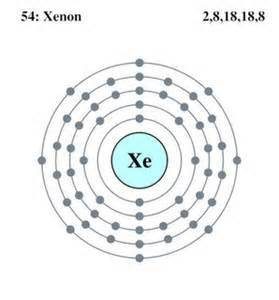
Xenon Electron Configuration (Bohr Model)
What is it Used for
- Since it produces a blue glow when electrically excited, xenon is used in specialized light sources such as high-speed photographic flash bulbs, bactericidal lamps for food preparation and processing, and sunbed lamps [1].
- Xenon lamps are commonly used in solid-state ruby lasers [1].
- High-intensity discharge (HID) xenon lights, used as headlights in cars and bikes, are more stable, economically friendly, and brighter than normal halogen light bulbs [3].
- High-pressure xenon arc lamps are used for producing ultraviolet light and motion picture projection [8].
- Xenon difluoride is used as silicon etchant in microprocessors [1].
- Modern ion propulsion systems in spacecraft use inert gases, specifically xenon because it reduces the risks of explosions linked with chemical propulsion [1, 8].
- Instruments like bubble chambers, and X-ray and neutron counters use xenon for radiation detection [8].
- It is used in the production of 5-fluorouracil, a medication used for reducing cancer, as well as manufacturing other drugs that help treat other health conditions [1].
Xenon Toxicity
Although xenon is not a toxic element and has no biological role, its compounds are considered to be highly toxic because of their strong oxidizing nature [1, 8].
Interesting Facts
- Two of its compounds, xenon trioxide and xenon tetroxide are highly explosive [8].
- Addition of xenon atoms to liquid helium helps in observing quantum tornadoes, which are vortexes controlled by quantum numbers [4].
- An important radioisotope of iodine – 131I undergoes radioactive disintegration to form stable xenon [4].
- Xenon is graphically represented by an icon of an ‘electro-flash’ that indicates its use in photographic flash technology [1].
Xenon Cost
The price of pure xenon is about $1.2 per gram [8].
- References
- http://www.rsc.org/periodic-table/element/54/xenon
- https://education.jlab.org/itselemental/ele054.html
- https://chem.libretexts.org/Textbook_Maps/Inorganic_Chemistry/Supplemental_Modules_(Inorganic_Chemistry)/Descriptive_Chemistry/Elements_Organized_by_Block/2_p-Block_Elements/Group_18%3A_The_Noble_Gases/Z%3D54_Chemistry_of_Xenon_(Z%3D54)
- https://www.livescience.com/37504-facts-about-xenon.html
- https://education.jlab.org/itselemental/iso054.html
- https://journals.aps.org/prc/abstract/10.1103/PhysRevC.89.015502
- https://www.webqc.org/molecular-weight-of-Xe.html
- https://www.chemicool.com/elements/xenon.html
- Lenntech.com
- http://periodictable.com/Elements/054/data.html
- http://chemistry-reference.com/q_elements.asp?Symbol=Xe
- https://cameochemicals.noaa.gov/chemical/1703
